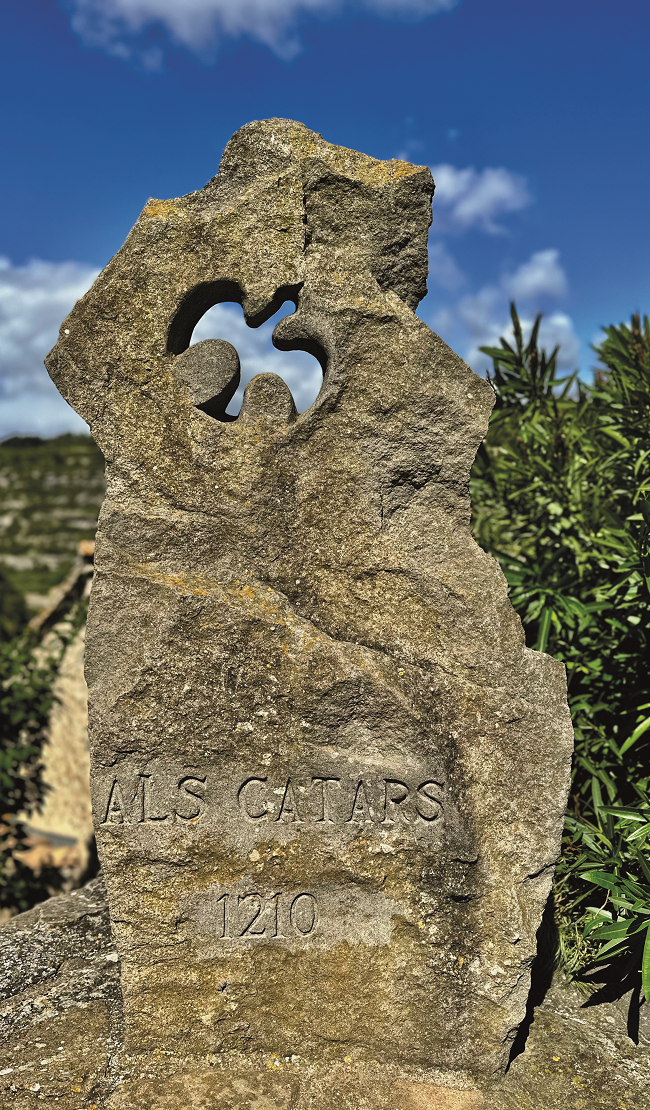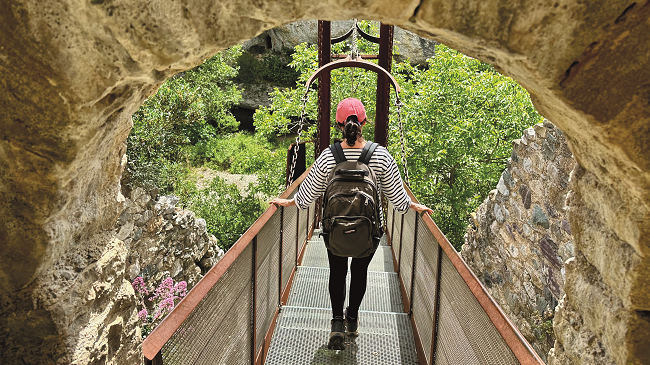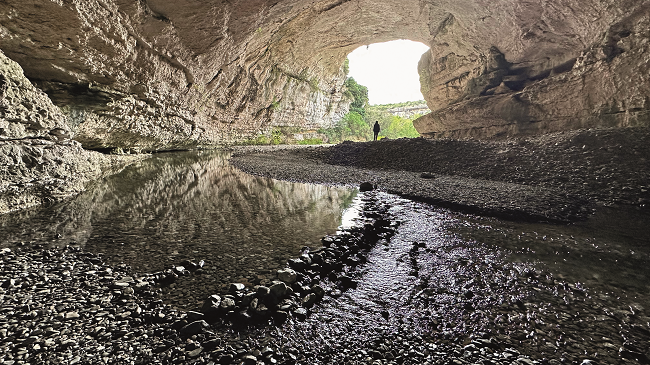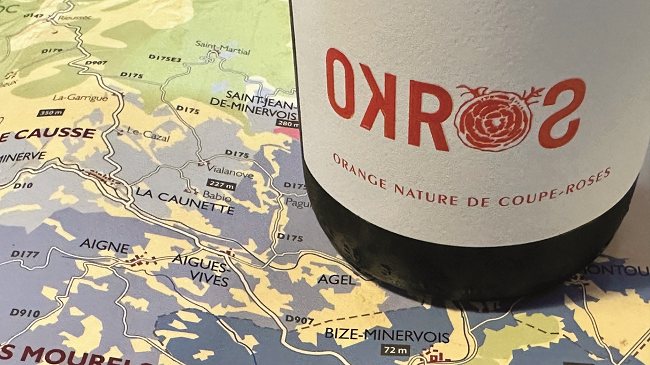Treasures of the Minervois

Go off the beaten track in Hérault and discover the richness of the Minervois region in Occitanie.
Strolling through the narrow, cobbled streets of Minerve (one of France’s Plus Beaux Villages), we are charmed at every turn. There are cute boutique shops selling objets d’art, enticing cafés and restaurants, and well-aged caveaux offering wine-tasting opportunities. But the sign on one of the streets – Rue des Martyrs – stops us in our tracks, and sends a haunting reminder of what once happened here.
Just beyond this, we discover a small square and a stone sculpture. At the top of the artwork, a hole has been carved in the shape of a dove, and below this there is a simple inscription: ‘Als Catars‘, Occitan for ‘In memory of the Cathars’. Jean-Christophe Mahieu, our guide from the local tourist office, informs us that the sculpture is called La Colombe de Lumière (Dove of Light) and was made by local artist Jean-Luc Séverac, who died last year. He also tells us that the Église Saint-Étienne overlooking the square holds the oldest altar in France, dating from 456.

© Steve Turnbull
Continuing our tour, we learn more about the Cathars, a Christian sect from the Middle Ages who held strong beliefs about the dualistic (good and evil gods’) nature of creation that challenged the authority of the Catholic Church. Minerve, at the heart of what we now know as Languedoc, was one of their strongholds. They chose the location because the deep gorges surrounding it provided a formidable defence. But in 1210, after sacking Carcassonne and Béziers, the forces of the Albigensian Crusade, led by Simon de Montfort, laid siege to the village. To cut a long story short, this resulted in well over 100 of the heretical Cathars being burned at the stake.
As we clamber down the recently renovated ramparts on the eastern flank of the village, Jean-Christophe points out a reproduction trebuchet on the other side of the gorge. He then explains that this was used by the besiegers to hurl rotting animal corpses as well as boulders, contaminating the village’s water supply, hence its nickname, La Malvoisine (‘bad neighbour’). Archaeological findings show the site was occupied by the Visigoths in the fifth and sixth centuries, and by prehistoric tribes before them. Unfortunately, the small museum next to the church, which holds an impressive collection of artefacts, is closed, but there are plans to rehouse the collection in a new visitor centre. Meanwhile, you can visit the Musée Hurepel in the centre of the village, which recreates the Crusade with miniature sets and handmade figurines.
Minerve lies between the Massif de Montagne Noire to the north and the Canal du Midi to the south. It is also the western gateway to the wonderful Haut-Languedoc Park. As to the origin of the name Minerve itself, there are two different theories. Traditionally it was thought to derive from the Roman goddess, Minerva but a more modern interpretation looks to its Occitan version Menèrba, which comes from the Celtic ‘men’ (stone) and ‘herbech’ (refuge).

© Steve Turnbull
Natural Wonders
Minerve has been working towards Grand Site de France status since 2015, which reflects not only its exceptional interest in historical terms but also geologically. At the foot of the gorge we discover what looks like a cavernous cave, but, as the light at the other end reveals, this is a pont naturel carved out of the limestone (the technical term is karst relief) over many centuries by the river Cesse. Generally, this flows in the wetter months but dries up in the summer as it disappears underground.
Later we cross its tributary, the Brian, as we embark on the 9km Cité de Minerve walk, guided by a free map from the tourist office. Soon after, we reach the top of the climb and proceed along the path, flirting with the cliff edge and marvelling at the magnificent display of spring flowers, which are protected by the Natura 2000 label, as are animals in the area, notably bats and eagles. Having plunged back down into the gorge, we reach the Pont de Daniel. It’s a breathtakingly beautiful spot, but be warned: don’t be tempted to stop and take a selfie or you might end up on the rocks below. In fact, the ‘bridge’ is a mini- aqueduct, which explains the alarmingly low walls. We then continue the walk with a climb to the vast limestone plateau (causse) on the other side of the gorge where the garrigue landscape is wild and rugged. It also offers magnificent views of the Corbières hills in the distance, and the peaks of the Pyrenees beyond.
The next day we set off to explore the winemaking locally. Our first stop is the Château Coupe-Roses estate in the ‘lost in time’ village of La Caunette, just down the road from Minerve. Here, we are warmly greeted by Sarah Frissant and her partner, David Blon.

© Steve Turnbull
Oenologist Sarah is the latest generation of a long-standing family business and has clearly absorbed a lot of winemaking knowledge from her parents, as well as her professional studies. This is echoed by David as we taste their wines, all of which are organic (the estate has recently won an agroécologie award). But the one we find most intriguing is their Okros: a natural wine made without the addition of sulphites or yeast, it has a pale orange colour which results from the white (75% Roussanne, 25% Clairette) grapes being vinified like red, and more of the pigment being extracted from the skin.
Next we head to Saint-Jean-de-Minervois, a little village to the northwest, and hit the hiking trail once more on the 7km Petit Grain. This is a new oenorando, or wine walk, which provides an opportunity to enjoy wonderful scenery, experience the vineyards and discover local winemakers. The route is named after Muscat à petits grains – a small, white and tightly-clustered grape used to make fortified wine or vin doux naturel. This is produced in several areas of France but it is very much emblematic of the Minervois, which spans both the Hérault and Aude departments.
However, the region’s ‘white gold’ is the only wine made under the Saint-Jean-de-Minervois appellation. Created in 1948, this is one of the oldest in the Languedoc and one of the smallest in the country. Another characteristic of the Muscat grape is that it originates from Greece.
This makes it very suitable for the arid, typically Mediterranean soil around Saint-Jean-de- Minervois. But there are other reasons why the vines have thrived here: the high (250m-plus) altitude creates cooler nights and freshness, and the chalky stones carpeting the earth retain and release the sun’s warmth. Combined, these factors result in balanced temperatures and slow ripening, which in turn develops complexity.

© Steve Turnbull
A toast to the terroir
After the walk, which proved an absolute delight, we pay a visit to Clos du Gravillas. This small wine estate in Saint-Jean-de-Minervois has been run organically by American John Bojanowski and his French wife, Nicole, since the mid-1990s. During our extremely interesting tour of the winery, John explains that gravillas is Occitan for gravel – a nicely authentic touch.
We then sample some of the wines and quickly begin to appreciate why the estate has developed such an excellent reputation. But the one we’ve been really excited to try is its Muscat, Douce Providence. Muscat is normally drunk as a dessert wine/apéritif, so there’s no surprise about its floral bouquet and sweet-as-honey taste. But the wine as a whole is even better than we anticipated: it is beautifully balanced with just the right amount of acidity cutting through the sweetness, and lingers on the palate with notes of peach and pineapple.
Tasting the Muscat provides the perfect end to our trip. Not only does the wine capture the distinctiveness of the local terroir, but also the richness of the Minervois region. If you’ve yet to discover this part of France for yourself, you’re in for a treat.

© Steve Turnbull
Minervois essentials
GETTING THERE
BY AIR
There are regular Ryanair flights from London to Carcassonne, and fairly regular ones to Béziers, both of which are about an hour’s drive from Minerve.
BY TRAIN
There are six trains from Paris direct to Béziers per day, journey time around four hours.
www.sncf-connect.com/en-en
BY CAR
Around 8 hrs from Paris via the A75 and Béziers.
WHERE TO STAY & EAT
Relais Chantovent
Delicious and elegant French food in the heart of Minerve, with excellent service and superb views from the terrace. There are reasonably priced and comfortable rooms.
Le Jardin Tranquille
This home-style restaurant in Saint- Jean-de-Minervois, right on the oenorando, is run by Belgian Michèle van Kalck. It serves hearty, traditional French food, while vegetarians and vegans are also catered for.
TOURIST INFORMATION
minervois-caroux.com
From France Today Magazine
Lead photo credit : Minerve © Franck-A / shutterstock
Share to: Facebook Twitter LinkedIn Email
More in Cathars, French villages, Hérault, Minervois, occitanie, South of France, walking
Leave a reply
Your email address will not be published. Required fields are marked *




REPLY